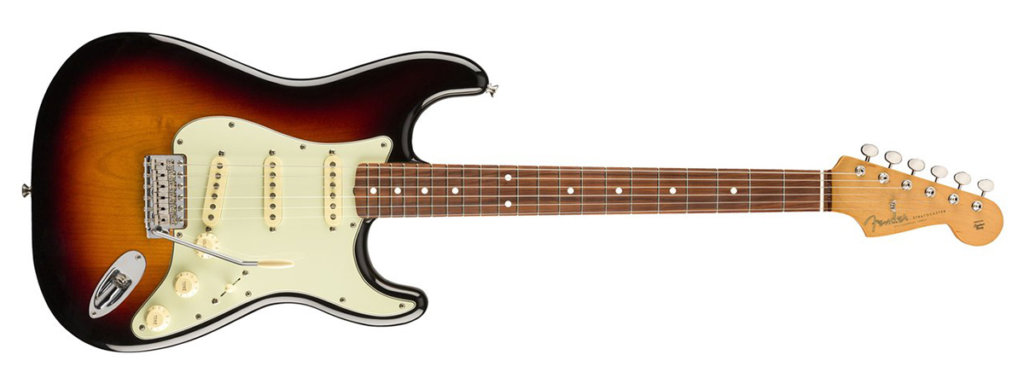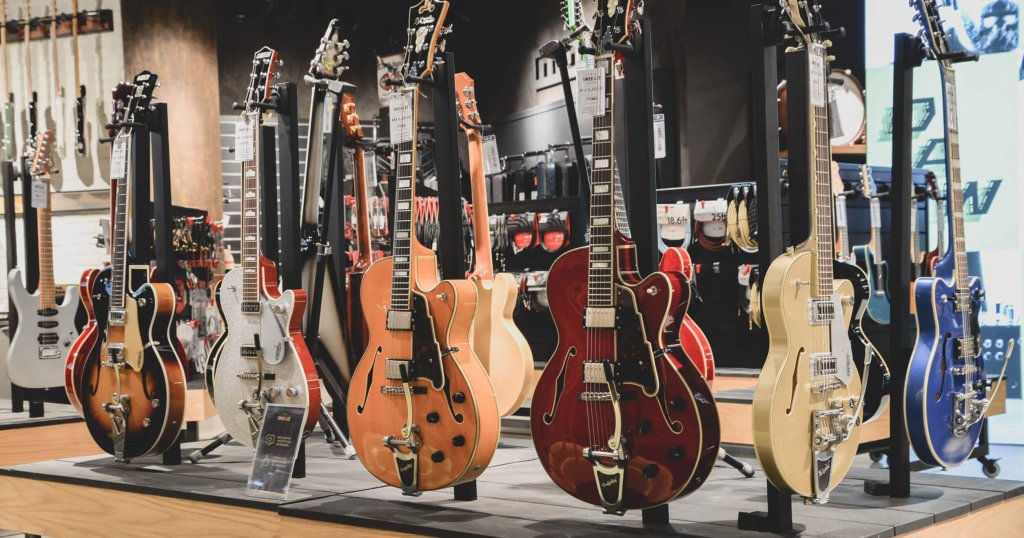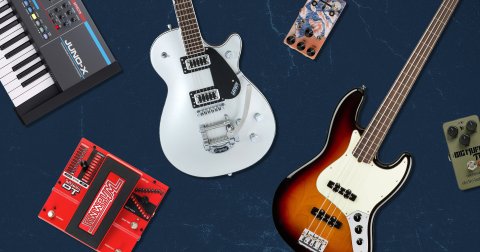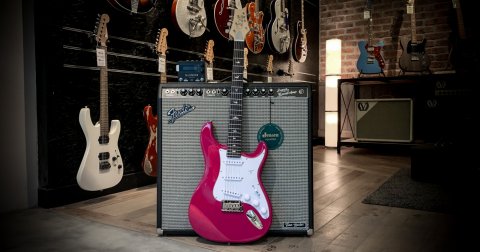The world seems to have ground to a standstill. Concerts and music festivals cancelled, mass gatherings curbed and movement controls have been coming into effect across the globe. Our Malaysia team and friends have a restricted movement order, and everywhere else, we’re being advised to stay home to help prevent the spread.
Staying home’s the best thing to do right now, but after days of exhausting all your TV shows, cooking the same meals and repeating the same routines, it’s understandable to be bored and restless.
In times like these, we musicians are lucky to have plenty to keep us occupied at home. You’re probably already playing your guitar right now! But do you find yourself stuck with the same old songs on your practice routine? Maybe ready to try something new?
To make your time at home more fun and productive, we’ve put together five songs/riffs to learn during your down time PLUS the gear that’ll get you close to the original tone. When this all tides over, you’ll be able to head back out and impress everyone with your new licks and chops!
AC/DC – Thunderstruck
AC/DC is easily one of the greatest rock ‘n’ roll bands of all time. Schoolboy outfit wearing, duck walking lead guitarist Angus Young is a big reason for their success, and rivals many others as the king of the guitar riff.
Released in 1990, “Thunderstruck” is very much the quintessential AC/DC creation – think high octane energy with simple lyrics that’ll have you singing along and headbanging to it. Their songs are relatively accessible for budding players, and we think “Thunderstruck” might be a great place to start if you are a beginner or an intermediate player looking to work on your fretting hand.
Why you should learn: The epochal intro you know and love starts off with a pedal point note on the B string. Written in the key of B, the guitar line in the intro outlines B major and E minor chords. Then the intro moves to a descending pattern in B Mixolydian while maintaining the pedal point B note.
Learning this song does two things for you – it helps improve your fretting hand’s dexterity with its non-stop hammer ons and pull offs. Secondly, dissecting apart this song gives you a front row seat to the music theory within one of rock’s most durable acts.
It’s no secret that a lot of AC/DC’s songs are usually written with mixolydian chord progressions (I-bVII-IV). In short, the mixolydian scale allows you to harness the “happy” nature of the major chord while lowering the 7th note of the scale by a half step to create an interesting musical progression. This allows the band to churn out epic songs that sound energetic but at the same time a little bluesy too. While it’s not strictly necessary, being able to play this song while doing the duck walk in a school uniform would be taking things to the next level!
Get that tone

Marshall Studio Vintage 1×10 Tube Combo Amplifier
As no-nonsense players that plug straight into their amps, Angus and Malcolm are proof that you don’t need a raft-sized pedalboard to sound great. Although it’s a well known fact both Angus and Malcolm utilised old-school Marshall Plexis for most of their most iconic sounds, you’d do best to slow down before you put down that deposit for a 100-watter.
The secret to the AC/DC tone is pushing the power amp tubes to the point of breakup and if you did just that at home the cops will come knocking in no time. Enter Marshall’s new SV20C Studio Vintage – specifically designed to capture the Marshall brown sound in a compact 20-watt combo while still employing a pair of EL34s — the same tubes used in the big plexis. The best part? Its power reduction circuit lets you dial down to 5W so you get the best tone possible at bedroom friendly volumes.
Your Hand in Mine – Explosions in the Sky
Explosions in the Sky are an American post-rock band that have spent the better part of the decade crafting dreamy symphonies with their guitars. If you’ve watched some American shows over the years, you’ll probably have heard a rendition of “Your Hand in Mine” to some capacity. It’s no accident that Explosions in the Sky often find their compositions in video productions, their songs have a very moody, ambient quality to them – perfect for filling a scene with emotion.
Why you should learn: First things first, there are two guitar parts in the entirety of the song; interwoven to each other seamlessly like two dancers performing the waltz. Of course, music theory a helps a great deal when dissecting a song apart. But for this piece, its spacing and purposefulness deserves to be enjoyed emotively and you’d do best learning the feel of the song instead.
The main takeaway from this song would be to master playing in the pocket and not overplaying. Letting your notes occupy the void and have space to bloom allows your songs to have a more profound impact on your listener. As nice as it is to shred away with the best of them, sometimes less is more. And for this song, we’d have to agree.
Get that tone

Strymon Volante Magnetic Echo Machine
As with most post rock bands, Explosions in the Sky go heavy on the delay and reverb. A wet mix of both effects help create a sense of space and is integral to the ethereal nature of their music. To kill two birds with a stone, the Strymon Volante Magnetic Echo Machine adds reverb capabilities on top of its already hefty delay unit. Far from a one trick pony, the Volante is able to effortlessly prance between lush vintage echoes and modern delay swelling repeats – making this one of the most versatile echo pedals we’ve laid our hands on.
Muse – Plug in Baby
Let’s head back to the beginning of the century, a time where mention of the year 2000 sounded uber-futuristic. Muse certainly thought so when they came up with the concept of “Plug In Baby”. Written about the sci-fi concepts pertaining to virtual reality and the singularity and the loss of individuality in the digital age – heavy stuff!
Featuring some of the most head-boppin riffs out there, “Plug In Baby” is most famous for its opening guitar riff which has been voted as one of the top 50 riffs of all time by multiple media sources.
Why you should learn: Let’s get the basics down: “Plug In Baby” is written in the key of B minor and is a hybrid between the harmonic minor and blues scale. A bit of context – the harmonic minor scale is commonly used by jazz musicians or classical composers for its darker “Arabic” or neoclassical sound. This tonality stems from the lowered third and sixth degrees (when compared to major scale) and is a good weapon to have in your theory arsenal. For examples of other pieces that utilise the harmonic minor scale, you can check out Bach’s “Toccata and Fugue in D minor, BWV 565”.
“Plug in Baby” probably isn’t the most challenging song to play, especially if you’ve been playing for some time, but it’s still a whole load of fun! Moving at a tempo of 140 bpm, playing the riff is a great warm-up set and exercise for finger independence at higher tempos. The winding modulus-like nature of the intro riff makes damn sure that you work every digit on your fretting hand. If you’re a newer player, learning this song is a great way to work on your picking dexterity.
Get that tone

If it’s Muse we’re talking about, you need a fuzz pedal. End of! In fact if you look up fuzz pedal in the dictionary, you’d might just see a picture of Matt Bellamy under it. One of the most prominent users of fuzz in the 21st century, you’d be hard pressed to find an aggressive track in Muse’s catalog without the usage of fuzz to some degree.
The Keeley Fuzz Bender is a modern fuzz using a combination of three high-gain silicon and silky smooth germanium transistors with active EQ, the Fuzz Bender is ultra-tweakable fuzzbox that provides huge value way beyond its price point. From aggressive “wooly mammoth” assaults to glitchy-Velcro attacks, almost anything is possible with the comprehensible controls from this immaculate fuzz unit.
Crossroads – Cream
A cover of Robert Johnson’s 1937 classic, Cream’s version was written by Eric Clapton around 1968. A little known fact: The version found on the album, Wheels of Fire, was actually a live performance at the Winterland Ballroom in San Francisco, California. While massively different from the original version, the song and consequently, the album was very successful and reached top rankings across the world.
Why you should learn: “Crossroads” is a great song to get started in playing fast blues. It’s gritty and raw, a great way to let out all your aggression from being locked indoors. For starters, “Crossroads” is a standard 12 bar blues song in the key of A. The main riff in the song consists of three chords: A, D7 and E. A lot of the song consists of embellishments (micro-bending, staccatos, etc.) and variations around the chords, so this is a fun song to experiment around with.
If you’re feeling up to it, learning the A minor pentatonic and A major pentatonic shapes would go a long way to helping you get right on to improvising on this piece. Top tip: switch it up between these two scales to get results similar to Slowhand’s solo on the album but you’re also welcome to create your own concoctions to your taste.
Get that tone

Epiphone SG Standard ’61 Electric Guitar, Vintage Cherry
Eric Clapton is best known as a Strat player today, but before he adopted the single coiled Fenders, he built his reputation as a guitar player playing mostly on Gibsons. During his Cream days, he toured and recorded with his infamous SG known as “The Fool”, which started its life out as a 1964 SG Standard before he got it painted in its iconic artwork. It was during this time with Cream his “woman tone” became one of the holy grails of guitar tone.
Epiphone’s new take on the Standard SG during the 60s is part of their “Inspired by Gibson” Collection, and bears all the hallmarks of a solid, reliable SG. To nail the tone on the intro lick, dial your neck pickup’s tone knob to zero, and play through a thick, overdriven amp.
Lenny – Stevie Ray Vaughn
As with most lists, we’ve left the hardest one for last. One of the quintessential SRV song, “Lenny” should be on every guitar players’ list of must-learn songs. With its iconic opening and soulful lead lines, the challenge of completing a 100% play-through of this song involves learning the many nuances and sheer emotion that Stevie Ray imparted on Texas Flood.
Why you should learn: Lenny is one of those bluesy numbers where guitarist will always bring up the term “feel”. It’s a relatively slow temp but it’s not easy feat, forcing you to impart emotion to your playing and makes you more deliberate in your note choices. Additionally, SRV is famous for the use of inflections on this track. Mastery of this track will no doubt enhance your vibrato by and/or whammy bar control. This allows you to add tasteful flavours to your solos and another dimension to your playing!
Lastly, learning this track will allow you to gain familiarity with the major, pentatonic and blues scales. The solos in “Lenny” work around the framework of the E major scale, E minor Pentatonic scale, and E minor Blues scale. During your odyssey to learn through the whole song, you’ll gain an understanding of how to incorporate these scales into your playing as well.
Get that tone

Fender Vintera 60s Stratocaster
Stevie Ray’s iconic tone stems from the expressiveness and dynamism of his playing and his axe of choice has always been the Stratocaster. The single coils deliver the bell like chime and bright, uncompressed tone which work brilliantly for the aggressive yet delicate playing SRV is famous for.
SRV’s no. 1 guitar began life as 60s Stratocaster, and Fender’s Vintera 60s Stratocaster comes close to the original specs without breaking the bank. Flip the pickup switch to position 4, hold on tight to your whammy bar and strum away.
If this article has ignited the flame of music self improvement with you don’t hesitate to hop on to our site at sweelee.com! To all of you staying home and doing your part, and especially our friends in Malaysia, you don’t have to step out of the comfort of your home to get your music gear. Place your order online and in a few days time you’ll have a New Gear Day to put a smile on your face during this tough times!



